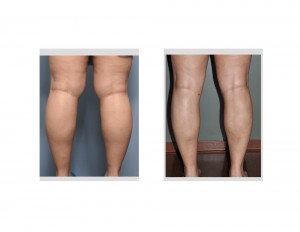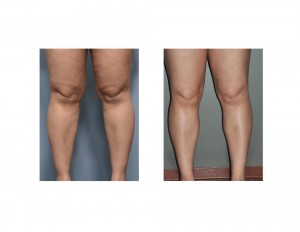Background: Liposuction is performed over many areas of the body, most commonly in the trunk region. (abdomen, chest and flanks) Its success is largely dependent on how well the overlying skin can retract after the underlying fat is removed. There are numerous types of liposuction that claim superior results if used. But the key to liposuction success is proper patient selection and the skill of the practitioner using the liposuction device.
Liposuction is also be performed in the extremities (arms and legs) although with less frequency than that of the trunk. The principles by which liposuction works in the extremities is the same as anywhere else. But the legs pose unique challenges for good liposuction results. Skin retraction is often not as good due to the circumferential nature of the tissues and prolonged edema may result from increased venous pressures below the knees with delayed lymphatic outflow. Longer recovery times and prolonged use of compression garments is essential to get good skin retraction around the reduced fat areas.
Some women are afflicted with thicker lower legs, which they may refer to as ‘tree trunks’. This description is somewhat applicable as it refers to a lower leg that has no shape and is more of a straight line from the knees down to the ankles. The knees are thick, often with an inner bulge and the underlying calfs have no discernible shape. This is often a source of embarrassment and may even prevent them from wearing anything other than pants to hide them.
Case Study: This 33 year-old female had always had thick and unshapely legs. They did not match the rest of her body and made her look ‘fat’. She never wore shorts and did not really like warm weather because of her clothing limitations. Liposuction was offered to her as the only treatment option with the understanding it could give her lower legs more shape although not necessarily make them a lot smaller.

Her three month postoperative results showed more shapely lower legs. The inner knees had less of a bulge, a medial infrapatellar indentation was evident as was a lower calf contour that turned inward towards the ankles.
Case Highlights:
1) Liposuction of the knees and calfs can help create lower legs that are more shapely and look less like ‘tree trunks’.
2) Liposuction of the lower legs is about creating a more shapely outline than overall size reduction.
3) Liposuction of the lower legs takes up to three months after surgery for all swelling to finally subside and see the final shape.
Dr. Barry Eppley
Indianapolis, Indiana



